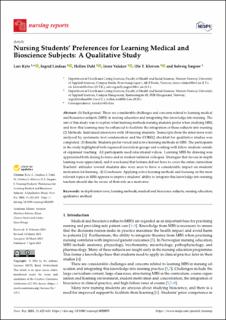| dc.contributor.author | Kyte, Lars | |
| dc.contributor.author | Lindaas, Ingrid | |
| dc.contributor.author | Dahl, Hellen | |
| dc.contributor.author | Valaker, Irene | |
| dc.contributor.author | Kleiven, Ole Tormod | |
| dc.contributor.author | Sægrov, Solveig Nelly | |
| dc.date.accessioned | 2024-04-10T09:08:49Z | |
| dc.date.available | 2024-04-10T09:08:49Z | |
| dc.date.created | 2023-08-28T13:58:50Z | |
| dc.date.issued | 2023 | |
| dc.identifier.citation | Nursing Reports. 2023, 13 (2), 622-633. | en_US |
| dc.identifier.issn | 2039-439X | |
| dc.identifier.uri | https://hdl.handle.net/11250/3125732 | |
| dc.description.abstract | (1) Background: There are considerable challenges and concerns related to learning medical and bioscience subjects (MBS) in nursing education and integrating this knowledge into nursing. The aim of this study was to explore what learning methods nursing students prefer when studying MBS, and how this learning may be enhanced to facilitate the integration of these subjects into nursing. (2) Methods: Individual interviews with 10 nursing students. Transcripts from the interviews were analysed by systematic text condensation and the COREQ checklist for qualitative studies was completed. (3) Results: Students prefer varied and active learning methods in MBS. The participants in the study highlighted both organised tutorials in groups and working with fellow students outside of organised teaching. All participants used educational videos. Learning MBS by drawing was appreciated both during lectures and in student-initiated colloquia. Strategies that favour in-depth learning were appreciated, and it was found that lectures did not have to cover the entire curriculum. Teachers’ attitudes toward students also were seen to have a considerable impact on students’ motivation for learning. (4) Conclusion: Applying active learning methods and focusing on the most relevant topics in MBS appears to improve students’ ability to integrate this knowledge into nursing; teachers should also be aware of their role as a motivator.
Keywords: in-depth interviews; learning methods; medical and bioscience subjects; nursing education; qualitative method | en_US |
| dc.language.iso | eng | en_US |
| dc.publisher | MDPI | en_US |
| dc.rights | Navngivelse 4.0 Internasjonal | * |
| dc.rights.uri | http://creativecommons.org/licenses/by/4.0/deed.no | * |
| dc.title | Nursing Students’ Preferences for Learning Medical and Bioscience Subjects: A Qualitative Study | en_US |
| dc.type | Peer reviewed | en_US |
| dc.type | Journal article | en_US |
| dc.description.version | publishedVersion | en_US |
| dc.rights.holder | © 2023 by the authors | en_US |
| dc.source.pagenumber | 622-633 | en_US |
| dc.source.volume | 13 | en_US |
| dc.source.journal | Nursing Reports | en_US |
| dc.source.issue | 2 | en_US |
| dc.identifier.doi | 10.3390/nursrep13020055 | |
| dc.identifier.cristin | 2170251 | |
| cristin.ispublished | true | |
| cristin.fulltext | original | |
| cristin.qualitycode | 1 | |

